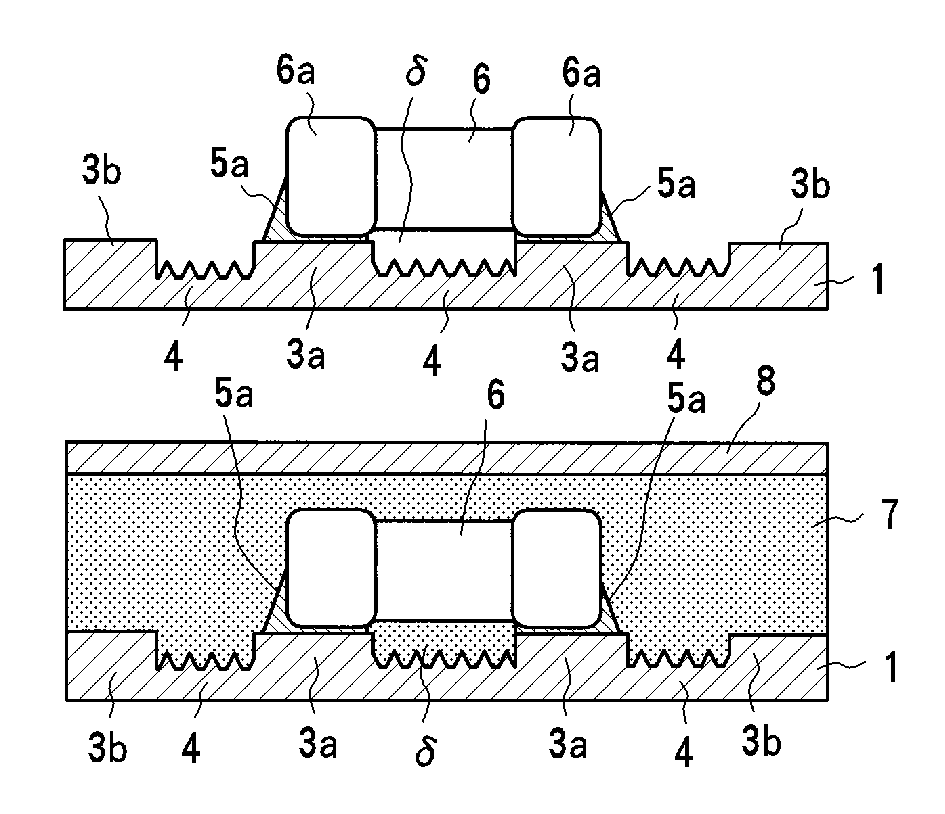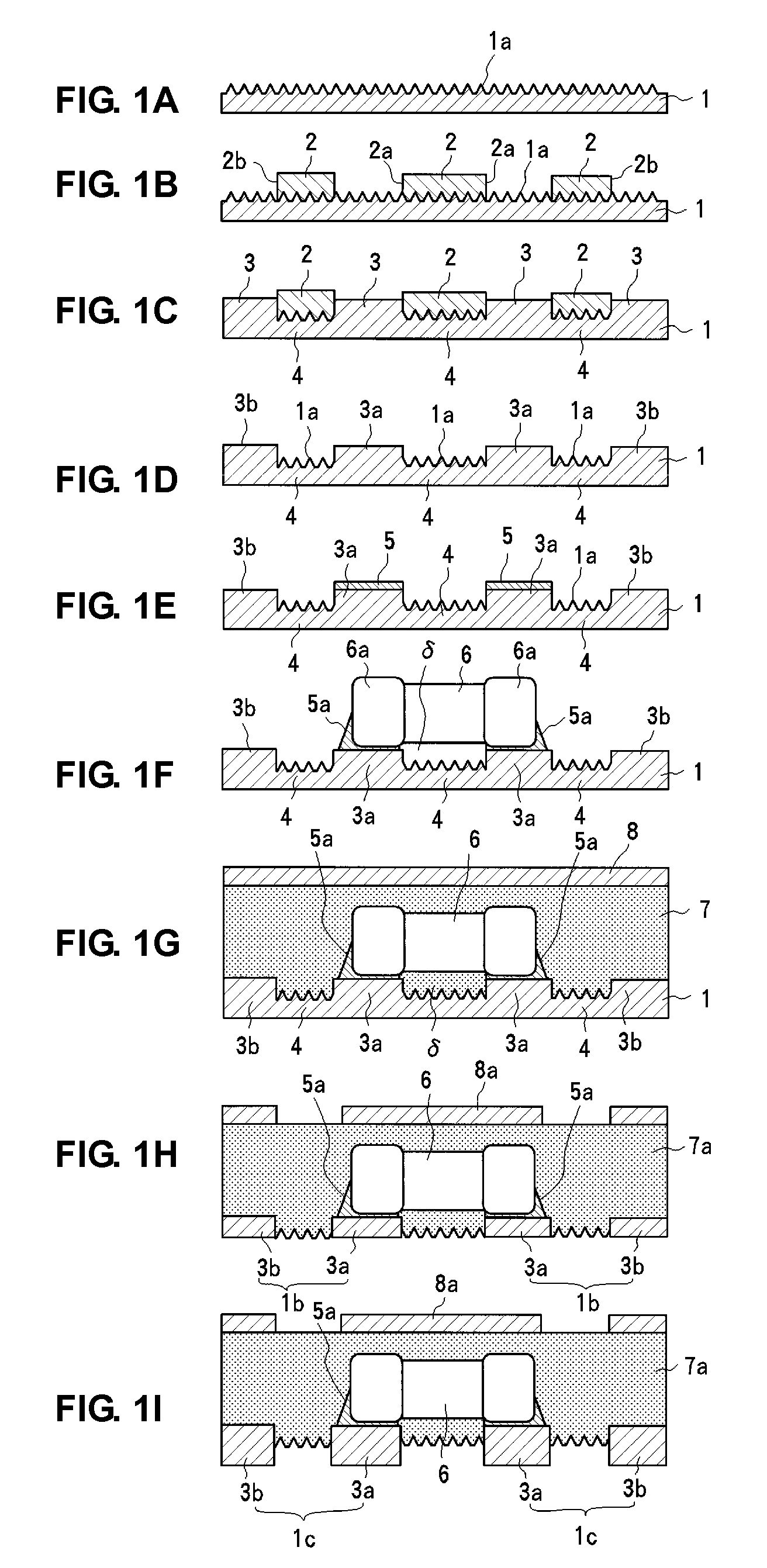Method for manufacturing substrate having built-in components
a technology of built-in components and substrates, which is applied in the direction of sustainable manufacturing/processing, final product manufacturing, printed circuit non-printed electric components association, etc., can solve the problems of high probability of solder flow, short circuit, and reliability problems, and achieve the effect of preventing short circui
- Summary
- Abstract
- Description
- Claims
- Application Information
AI Technical Summary
Benefits of technology
Problems solved by technology
Method used
Image
Examples
first preferred embodiment
Hereinafter, a first preferred embodiment of a method for manufacturing a substrate having built-in components according to the present invention will be described with reference to FIGS. 1A to 1I. In order to simplify the illustration, FIGS. 1A to 1I show a portion of a manufacturing process of a substrate having built-in components in which only one circuit component is included. However, an actual substrate having built-in components includes a plurality of circuit components. Furthermore, in an actual manufacturing process, a substrate having built-in components is made in a mother substrate state and is then individually obtained therefrom by cutting the mother substrate.
FIG. 1A shows a first step in which a metal foil 1 having a rough surface 1a formed entirely or substantially entirely at one primary surface side is prepared. The metal foil 1 is processed in a subsequent eighth step which will be described later, so that a wiring pattern is formed on one surface of the substr...
second preferred embodiment
Next, a second preferred embodiment of the method for manufacturing a substrate having built-in components according to the present invention will be described with reference to FIGS. 4A to 4J.
FIG. 4A shows a first step in which an oxide film 11a is formed entirely or substantially entirely on one primary surface of a metal foil 11. A material and a thickness of the metal foil 11 are substantially the same as those in the first preferred embodiment. As a method for forming the oxide film 11a, any method, such as a thermal treatment or a chemical treatment, for example, may preferably be used. In this example, although the oxide film 11a is formed on a flat surface of the metal foil 11, a roughened metal foil surface as shown in FIG. 1 may be processed by an oxidation treatment.
FIG. 4B shows a second step in which a plating resist 12 is pattern-formed on the oxide film 11a of the metal foil 11. A material and a pattern forming method of the plating resist 12 are substantially the sam...
third preferred embodiment
Next, a third preferred embodiment of the method for manufacturing a substrate having built-in components according to the present invention will be described with reference to FIGS. 5A to 5I. Since steps shown in FIG. 5A to 5C are substantially the same as those shown in FIG. 1A to 1C, the same reference numerals as those in FIGS. 1A to 1C are used, and a description is omitted.
In a step shown in FIG. 5D, Sn or Sn-alloy plating is preferably performed on the surface of the metal foil 1 on which the plating resist 2 is formed, so that pre-coat layers 20 are formed. In this example, since the land regions 3a and the wiring regions 3b are exposed through the opening portions of the plating resist 2, the pre-coat layers 20 are formed on the regions. As the Sn alloy, for example, Sn—Ag, Sn—Bi, Sn—Ag—cu, and other suitable Sn alloys may preferably be used. As a plating method, any suitable method, such as an electroless plating method or an electroplating method, for example, may prefera...
PUM
| Property | Measurement | Unit |
|---|---|---|
| thickness | aaaaa | aaaaa |
| surface roughness Rz | aaaaa | aaaaa |
| thickness | aaaaa | aaaaa |
Abstract
Description
Claims
Application Information
 Login to View More
Login to View More - R&D
- Intellectual Property
- Life Sciences
- Materials
- Tech Scout
- Unparalleled Data Quality
- Higher Quality Content
- 60% Fewer Hallucinations
Browse by: Latest US Patents, China's latest patents, Technical Efficacy Thesaurus, Application Domain, Technology Topic, Popular Technical Reports.
© 2025 PatSnap. All rights reserved.Legal|Privacy policy|Modern Slavery Act Transparency Statement|Sitemap|About US| Contact US: help@patsnap.com



